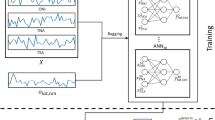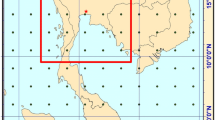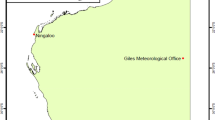Abstract
The monthly prediction of summer monsoon rainfall is very challenging because of its complex and chaotic nature. In this study, a non-linear technique known as Artificial Neural Network (ANN) has been employed on the outputs of Global Climate Models (GCMs) to bring out the vagaries inherent in monthly rainfall prediction. The GCMs that are considered in the study are from the International Research Institute (IRI) (2-tier CCM3v6) and the National Centre for Environmental Prediction (Coupled-CFSv2). The ANN technique is applied on different ensemble members of the individual GCMs to obtain monthly scale prediction over India as a whole and over its spatial grid points. In the present study, a double-cross-validation and simple randomization technique was used to avoid the over-fitting during training process of the ANN model. The performance of the ANN-predicted rainfall from GCMs is judged by analysing the absolute error, box plots, percentile and difference in linear error in probability space. Results suggest that there is significant improvement in prediction skill of these GCMs after applying the ANN technique. The performance analysis reveals that the ANN model is able to capture the year to year variations in monsoon months with fairly good accuracy in extreme years as well. ANN model is also able to simulate the correct signs of rainfall anomalies over different spatial points of the Indian domain .







Similar content being viewed by others
References
Abbot, J., & Marohasy, J. (2012). Application of artificial neural networks to rainfall forecasting in Queensland. Australia. Adv. Atmos. Sci., 29, 717–730. doi:10.1007/s00376-012-1259-9.
Acharya, N., Kar, S. C., Mohanty, U. C., Kulkarni, M. A., & Dash, S. K. (2011). Performance of GCMs for seasonal prediction over India-a case study for 2009 monsoon. Theoretical and applied climatology, 105, 505–520. doi:10.1007/s00704-010-0396-2.
Ajaya Mohan, S. R., & Goswami, N. B. (2003). Potential predictability of the Asian summer monsoon on monthly and seasonal time scales. Meteorology and Atmospheric Physics, 84, 83–100. doi:10.1007/s00703-002-0576-4.
Bose, N. K., & Liang, P. (1998). Neural network fundamentals with graphs, algorithms, and applications. New Delhi: Tata McGraw-Hill.
Charaniya, N.A., Dudul, S.V. (2012). Focused time delay neural network model for rainfall prediction using indian ocean dipole index, in: Proceedings of the 2012 fourth international conference on computational intelligence and communication networks, CICN’12. IEEE Computer Society, Washington, DC, USA, pp. 851–855. doi:10.1109/CICN.2012.116.
Doblas-Reyes, F. J., Hagedorn, R., & Palmer, T. N. (2005). The rationale behind the success of multi-model ensembles in seasonal forecasting—II. Calibration and combination. Tellus A, 57, 234–252. doi:10.1111/j.1600-0870.2005.00104.x.
Fausett, L. V. (1994). Fundamentals of neural networks: architectures, algorithms, and applications (40th ed.). Englewood Cliffs: Prentice-Hall.
Gadgil, S., & Sajani, S. (1998). Monsoon precipitation in the AMIP runs. Climate Dynamics, 14, 659–689. doi:10.1007/s003820050248.
Gadgil, S., & Srinivasan, J. (2011). Seasonal prediction of the Indian monsoon. Current Science, 100, 343–353.
Goswami, P., & Srividya, (1996). A novel neural network design for long-range prediction of rainfall pattern. Current Science, 70, 447–457.
Guhathakurta, P. (2008). Long lead monsoon rainfall prediction for meteorological sub-divisions of India using deterministic artificial neural network model. Meteorology and Atmospheric Physics, 101, 93–108. doi:10.1007/s00703-008-0335-2.
Hecht-Nielsen, R. (1990). Neurocomputing (pp. 115–117). Reading: Addison-Wesley.
Hung, N. Q., Babel, M. S., Weesakul, S., & Tripathi, N. K. (2009). An artificial neural network model for rainfall forecasting in Bangkok, Thailand. Hydrology and Earth System Sciences, 13, 1413–1425. doi:10.5194/hess-13-1413-2009.
Janakiraman, S., Mohit, V., Ramesh, N. L., Priyanka, Y., & Sulochana, G. (2011). Prediction of the Indian summer monsoon rainfall using a state-of-the-art coupled ocean–atmosphere model. Current Science, 100, 354–362.
Kripalani, H. R., Oh, H. J., Kulkarni, A., Sabade, S. S., & Chaudhari, S. H. (2007). South Asian summer monsoon precipitation variability: coupled climate model simulations and projections under IPCC AR4. Theoretical and Applied Climatology, 90, 133–159. doi:10.1007/s00704-006-0282-0.
Kulkarni, M. A., Acharya, N., Kar, S. C., Mohanty, U. C., Tippett, M. K., Robertson, A. W., et al. (2012). Probabilistic prediction of Indian summer monsoon rainfall using global climate models. Theoretical and Applied Climatology, 107, 441–450. doi:10.1007/s00704-011-0493-x.
McCulloch, W. S., & Pitts, W. (1943). A logical calculus of the ideas immanent in nervous activity. The bulletin of mathematical biophysics, 5, 115–133. doi:10.1007/BF02478259.
Nair, A., Mohanty, U. C., & Acharya, N. (2013). Monthly prediction of rainfall over India and its homogeneous zones during monsoon season: a supervised principal component regression approach on general circulation model products. Theoretical and Applied Climatology, 111, 327–339. doi:10.1007/s00704-012-0660-8.
Nair, A., Mohanty, U. C., Robertson, A. W., Panda, T. C., Luo, J.-J., & Yamagata, T. (2014). An analytical study of hindcasts from general circulation models for Indian summer monsoon rainfall. Meteorological Applications, 21, 695–707. doi:10.1002/met.1395.
Navone, H. D., & Ceccatto, H. A. (1994). Predicting Indian monsoon rainfall: a neural network approach. Climate Dynamics, 10, 305–312. doi:10.1007/BF00228029.
Pai, D.S., Bhan, S.C. (2015). Monsoon Report 2014 IMD Met. Monograph: ESSO Document No.: ESSO/IMD/Synoptic Met./01(2015)/17.
Pal, S., Das, J., Sengupta, P., & Banerjee, S. K. (2002). Short term prediction of atmospheric temperature using neural networks. Mausam, 53, 471–480.
Pattanaik, D. R., & Kumar, A. (2010). Prediction of summer monsoon rainfall over India using the NCEP climate forecast system. Climate Dynamics, 34, 557–572. doi:10.1007/s00382-009-0648-y.
Potts, J. M., Folland, C. K., Jolliffe, I. T., & Sexton, D. (1996). Revised “LEPS” scores for assessing climate model simulations and long-range forecasts. Journal of Climate, 9, 34–53. doi:10.1175/1520-0442(1996)009<0034:RSFACM>2.0.CO;2.
Prasad, K., Dash, S. K., & Mohanty, U. C. (2010). A logistic regression approach for monthly rainfall forecasts in meteorological subdivisions of India based on DEMETER retrospective forecasts. International Journal of Climatology, 30, 1577–1588. doi:10.1002/joc.2019.
Rajeevan, M., Bhate, J., Kale, J., & Lal, B. (2006). High resolution daily gridded rainfall data for the Indian region: analysis of break and active monsoon spells. Current Science, 91, 296–306.
Ramasubramanian, V. (2007). Time series analysis. New Delhi: IASRI.
Roeckner, E., Arpe, K., Bengtsson, L., Christoph, M., Claussen, M. (1996). The atmospheric general circulation model ECHAM4: model description and simulation of present-day climate. Max-Planck-Institut für Meteorologie, MPI Report No. 218, Hamburg, Germany, pp 90.
Saha, S., Moorthi, S., Wu, X., Wang, J., Nadiga, S., Tripp, P., et al. (2014). The NCEP climate forecast system version 2. Journal of Climate, 27, 2185–2208. doi:10.1175/JCLI-D-12-00823.1.
Saha, S., Nadiga, S., Thiaw, C., Wang, J., Wang, W., Zhang, Q., et al. (2006). The NCEP climate forecast system. J. Climate, 19, 3483–3517. doi:10.1175/JCLI3812.1.
Sahai, K. A., Soman, K. M., & Satyan, V. (2000). All India summer monsoon rainfall prediction using an artificial neural network. Climate Dynamics, 16, 291–302. doi:10.1007/s003820050328.
Sikka, D. R., & Ratna, S. B. (2011). On improving the ability of a high-resolution atmospheric general circulation model for dynamical seasonal prediction of the extreme seasons of the Indian summer monsoon. Mausam, 62, 339–360.
Singh, P., & Borah, B. (2013). Indian summer monsoon rainfall prediction using artificial neural network. Stochastic environmental research and risk assessment., 27, 1585–1599. doi:10.1007/s00477-013-0695-0.
Singh, G., & Panda, R. K. (2011). Daily sediment yield modeling with artificial neural network using 10-fold cross validation method: a small agricultural watershed, Kapgari, India. International Journal of Earth Sciences and Engineering., 4, 443–450.
Singh, G., & Panda, R. K. (2015). Bootstrap-based artificial neural network analysis for estimation of daily sediment yield from a small agricultural watershed. International Journal of Hydrology Science and Technology., 5, 333–348. doi:10.1504/IJHST.2015.072634.
Singh, G., Panda, R. K., & Lamers, M. (2015). Modeling of daily runoff from a small agricultural watershed using artificial neural network with resampling techniques. JJournal of Hydroinformatics., 17, 56–74. doi:10.2166/hydro.2014.106.
Sivanandam, S. N., & Deepa, S. N. (2007). Principles of soft computing. New Delhi: Wiley.
Van den Dool, H. M. (1994). Searching for analogues, how long must we wait? Tellus A, 46, 314–324. doi:10.1034/j.1600-0870.1994.t01-2-00006.x.
Venkatesan, C., Raskar, S. D., Tambe, S. S., Kulkarni, B. D., & Keshavamurty, R. N. (1997). Prediction of all India summer monsoon rainfall using error-back-propagation neural networks. Meteorology and Atmospheric Physics, 62, 225–240. doi:10.1007/BF01029704.
Ward, M. N., & Folland, C. K. (1991). Prediction of seasonal rainfall in the north nordeste of Brazil using eigenvectors of sea-surface temperature. International Journal of Climatology, 11, 711–743. doi:10.1002/joc.3370110703.
Zhang, H., & Casey, T. (2000). Verification of Categorical Probability Forecasts. Weather Forecast., 15, 80–89. doi:10.1175/1520-0434(2000)015<0080:VOCPF>2.0.CO;2.
Acknowledgements
This study is conducted as part of a research project entitled ‘Development and Application of Extended Range Weather Forecasting System for Climate Risk Management in Agriculture’, sponsored by the Department of Agriculture and Cooperation, Government of India. India Meteorological Department (IMD) is duly acknowledged for Gridded rainfall data. We are thankful to the IRI modeling and prediction groups (USA) led by D. Dewitt for making the GCMs available for users. The authors are also thankful to the anonymous reviewers for their valuable comments and suggestions by which the quality of the paper is enhanced. We also thank the NCAR Climate System Laboratory (CSL) program that partially sponsored the computations of GCMs.
Author information
Authors and Affiliations
Corresponding author
Rights and permissions
About this article
Cite this article
Nair, A., Singh, G. & Mohanty, U.C. Prediction of Monthly Summer Monsoon Rainfall Using Global Climate Models Through Artificial Neural Network Technique. Pure Appl. Geophys. 175, 403–419 (2018). https://doi.org/10.1007/s00024-017-1652-5
Received:
Revised:
Accepted:
Published:
Issue Date:
DOI: https://doi.org/10.1007/s00024-017-1652-5




